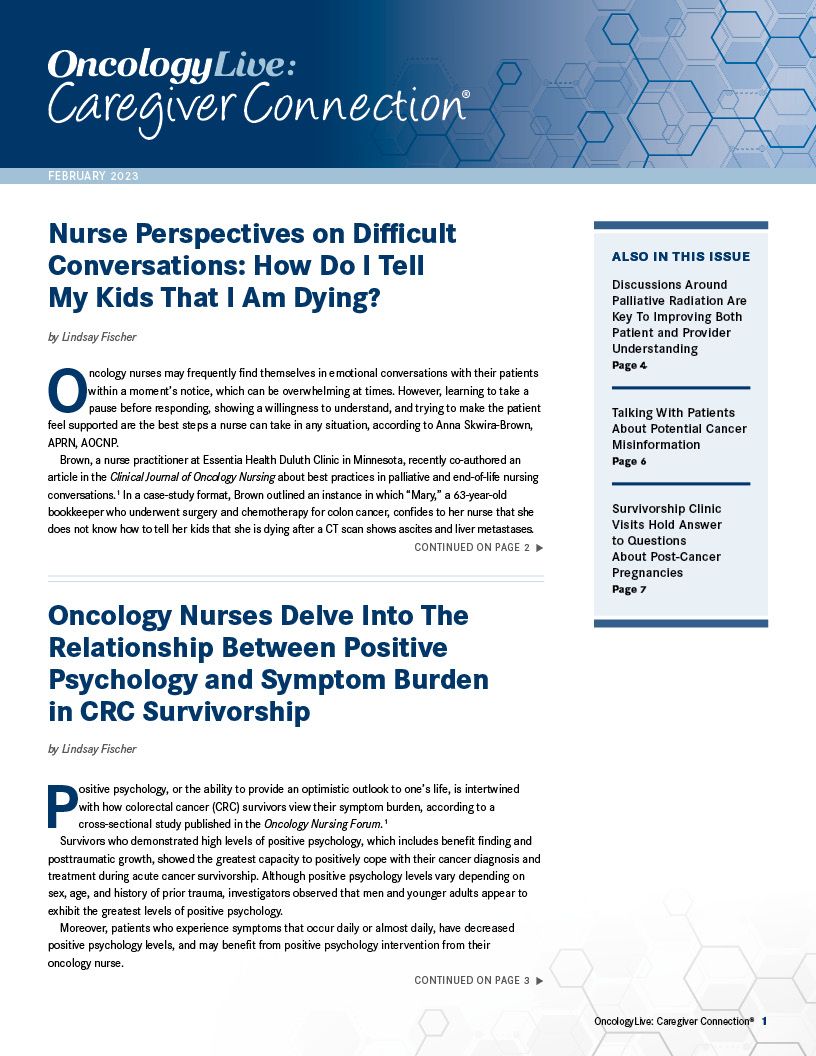Discussions Around Palliative Radiation Are Key To Improving Both Patient and Provider Understanding
Reanne Booker, MN, NP, shares how nurses can increase patient understanding on the role of palliative care in oncology.
Reanne Booker, MN, NP

Radiation therapy remains a pillar of oncology treatment, yet palliative radiotherapy is often misunderstood, according to Reanne Booker, MN, NP.1 However, nurses can play an important role in educating patients about this treatment and determining if it is appropriate for patients.
“Oncology nurses play a huge role in helping to address misperceptions and educating patients about the goals of palliative care,” said Booker, who is a nurse practitioner with the palliative and end of life care services program at the Foothills Medical Centre at Alberta Health Services in Calgary, Alberta, as well as a PhD candidate at the University of Victoria in British Columbia, in an interview with Oncology Nursing News®.
“Nurses already are fantastic at providing or adopting a palliative approach to care,” she added. “[When it comes to palliative radiation], it’s all about listening to the patient, and making sure that the treatments we’re offering are aligning with patient’s goals and wishes.”
Booker recently performed a literature review on palliative radiation. The findings from her research, which were published in the Clinical Journal of Oncology Nursing, provide foundational information for nurses on indications for palliative radiation therapy, possible adverse effects and toxicities associated with treatment, and potential accessibility barriers patients may face.1
In an interview with Oncology Nursing News®, Booker highlighted the key takeaways form this research and the broader implications for oncology nursing practice.
Oncology Nursing News®: Are all patients eligible for palliative radiotherapy?
Booker: We know that approximately half of all patients will receive radiation therapy at some point in their disease and treatment trajectories. Approximately half of all prescribed radiotherapy is with palliative intent. But there are some patients who are better suited to receive palliative intent radiation therapy compared with others.
It’s really important that we consider a patient’s goals and wishes and to make sure that our treatment aligns with [that]. When it comes to radiation therapy, it can take between 1 to 4 weeks for patients to realize the full benefit of the treatment. So, if their prognosis is thought to be quite short—in the neighborhood of days or weeks—then that might not be the best option for them, because they wouldn’t potentially be able to realize the benefit of the treatment. Patients [also] need to be able to tolerate laying still on a hardtop table for at least 15 minutes. Depending on their physical condition, they may not be able to tolerate that. Some patients don’t like to have masks or things placed over their face, and, depending on the treatment sites, they may have to have that. [This] can cause anxiety and claustrophobia for some patients. Additionally, patients have to travel to and from the cancer center. If they live quite a distance, you have to really weigh those risks and benefits in terms of what’s the best option for the patient.
Can you differentiate between radiation therapy for curative intent vs palliative radiation therapy?
The biggest difference is the intent or the goals of the treatment. Palliative-intent radiation is meant to alleviate symptoms rather than cure the disease.
We really need to talk about the risks and benefit: what are the possible adverse effects that might happen? If the intent is to alleviate symptoms, but not necessarily cure the disease, then we need to make sure that those adverse effects of treatment don’t outweigh the benefits, especially in the palliative context. We have studies to show that patients are very often willing to deal with diminished quality of [life] if the treatment is meant to be curative. It’s a bit different [when] we know that the treatment won’t be curing the underlying cancer. Many patients would really argue that their quality of life is key, [so we] want to really think about that balance.
In your article, you present 2 very different case studies about patients and their decision to pursue or not pursue radiation therapy. What were the key concerns that these patients expressed and what advice might you have for nurses who find themselves in real-world situations similar to these?
These cases were based on real-[world] experiences I’ve had with details changed to preserve anonymity and confidentiality.
One patient is a 38-year-old nurse with history of metastatic breast cancer, who has undergone multiple lines of therapy. The other patient is a 78-year-old gentleman with many symptoms and a new diagnosis of multiple myeloma. In both cases, radiation was being offered as a palliative measure. So again, the goal was to alleviate symptoms to help improve quality of life.
It is imperative in the context of any palliative-intent treatment to ensure that the treatment harms don’t outweigh the benefits. So, for Abigail, the nurse, we knew her prognosis was estimated to be [approximately a few] short weeks. She’d already told us that she didn’t want to have any more disease directed treatment for breast cancer. Her goals were really to spend more time with her family and have good quality of life [and] she didn’t want to be spending her remaining time in the hospital or traveling to and from the cancer center. So, there are other options that we can pursue in terms of symptom management that were a better fit for her.
In contrast, for Justin, the gentleman, although the radiation therapy was also palliative, and not meant to cure the multiple myeloma, there was an expectation that the treatment would result in significant alleviation of his symptoms, as well as to help preserve function and prevent any further neurologic deterioration.
Both these cases highlight the importance of educating the patient first, and [define the] intent of the palliative treatment or any treatment. And then really making sure that we explore the goals and wishes of the patient to make sure that treatment aligns.
Nurses are well-suited to have these discussions with patients. We get to spend quite a bit of time with our patients, and we get to explore their situation comprehensively. For nurses who find these conversations challenging, [discuss the patient’s] goals and wishes and use that as a bit of a scaffolding or guide.
[Consider:] What does the patient hope to get out of treatment? Is their goal to live longer? Is it to live better? What are they willing to trade for the prospect of more time, what would be something that they would consider unacceptable in terms of a tradeoff? That might be adverse effects and might be time at the cancer center at the expense of time with their families, or loss of function.
What are some common barriers to receiving palliative radiation?
Access and equity can be a problematic challenge for many patients. I’m in Canada, but in both the United States and Canada, we know that patients who reside in very rural and remote areas have reduced access to some of these treatments and services, or, if they are able to access them, they are required to travel long distances and be away from family, and it is often a significant expense to be able to make those trips and travel.
I also think [there are] additional barriers in our language. For some patients, and even for some doctors and nurses and clinicians, hearing that word palliative can be very frightening. There are a lot of misperceptions that persist about palliative care where people still equate palliative care with end-of-life or hospice care. Sometimes, when we look at referring patients to palliative services, there can be reluctance because the clinicians don’t want to take away hope or they don’t want to cause undue distress to the patients. On the patient side, they can harbor those misperceptions about palliative care. They may not want to pursue any palliative treatments of any kind, because they might think that it means they’re dying.
Our language and explanations can be really helpful and as nurses, this is a place where we can provide that education to patients and their loved ones—to help them understand that palliative doesn’t mean the end or hospice, it just means we want to help make that experience as good as it possibly can be.
Globally, lack of access is a major problem, [with] 80% of the world’s patients with cancer [geographically residing] in low- and middle-income countries [and] having approximately 5% of global radiotherapy resources. So, access is a huge issue worldwide.
I often feel [that] when a patient decides to forego or move away from disease-directed or disease-modifying treatments there’s a sense that we’re giving up or there’s nothing more that can be done. In the palliative care world, we like to tell patients, there’s always more we can do. It may be that the goal has shifted a little bit and may not be cure anymore, but there’s still other goals we can work towards, and we can help patients achieve [them]. I feel there’s always so much we can do in terms of alleviating symptoms and helping to optimize quality of life.
Is there anything else that I didn't ask you that you wanted to highlight?
It would be ideal if cancer centers routinely integrated palliative care into standard patient care. That might just mean that we have triggers for when to refer patients. But embedding palliative care services right alongside even curative intent treatment can be really helpful.
Reference
Booker R. Palliative radiation therapy: the role of radiation therapy in palliative and end-of-life care. Clin J Oncol Nurs. 2022;26(6):628-635. doi:10.1188




